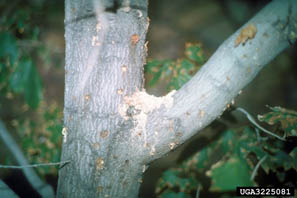Invasive Species Spotlight: Asian Longhorned Beetle | |
|---|---|
| September 4, 2008 | |
|
Once again,the Asian lonhHorned beetle (ALB) has made it back in the spotlight in Illinois. Four months after the beetle was declared eradicated from the Chicagoland area, it was found in Deerfield of August 2008. Authorities still are not sure if this is a new infestation brought into the area or a remnant of the previous infestation. Regardless, it has many people concerned and shows what a challenge it is to manage healthy and safe urban trees. The ALB was previously first identified in New York City in 1996. Two years later it was detected in a Chicago neighborhood and in 2002 in New Jersey. When entomologists and resource managers from numerous organizations first learned of the destructive potential of the insect, they quickly made plans to try and eradicate it. The first steps were to survey for damage and then to establish quarantine zones. Surveys were done using aerial lifts and tree climbers to thoroughly inspect all tree parts. Infested trees were removed and destroyed. Noninfested trees within the quarantine zones were treated with a systemic insecticide as a precautionary approach.  Larva. Photo courtesy of Steven Katovich, USDA Forest Service. Like many other beetles, the ALB goes through four life stages: egg, larva, pupa, and adult. The eggs are laid by adult beetles on the bark of living trees. A single female can lay up to 90 eggs a year, with each egg being placed in its own site. Eggs are encased in a brownish protective secretion about 1/4 inch in diameter. The larva emerges from this egg site in about 10 to 15 days and begins burrowing into the trees bark. They begin by feeding on the sapwood around the tree but later feed on the heartwood and overwinter in there. In the springtime they continue feeding until they begin their pupa stage. This may last over a week as it begins transformation into its adult form. They then exit the trees and begin to search for mates, with the cycle beginning again.  Damaged heartwood and adult beetle. Photo courtesy of E. Richard Hoebeke, Cornell University. Adult beetles can be from 1 to 1-1/2 inches long and are black with white specks on its elytra (wing covers) and have long white-and-black-banded antennae. Females tend to be a bit larger than the males. They greatest damage to trees is caused by the larva as they tunnel through the living tissues of the phloem and xylem. Ultimately, the tree looses its ability to transport water and nutrients to its canopy and roots, and it dies. Because the ALB can be quite large, it can also weaken the structural integrity of a tree.  Frass and sawdust left below holes. Photo courtesy of Robert A. Haack, USDA Forest Service. Visual symptoms of an infested tree can include the accumulation of frass on tree branch collars below holes caused by exiting beetles. Exit holes can be quite large and distinct from those of other longhorned beetles—up to 3/8 inch in diameter and almost perfectly circular. Adult beetles can also be found chewing on the veins of leafs, leaving the other leaf tissues intact. Egg sites can also be an important visual clue to the presence of ALB. Asian longhorned beetles have a wide range of preferred host trees. Most studies show that they prefer maple trees of any species. Other top choices include birch, horse chestnut, poplar, willow, elm, ash, hackberry, sycamore, mountain ash, and London plane tree. If you suspect the Asian longhorned beetle anywhere in Illinois, please contact the Illinois Department of Agriculture at 1(800)641-3934. (Kelly Estes) | |
| Author: | Phil Nixon |

